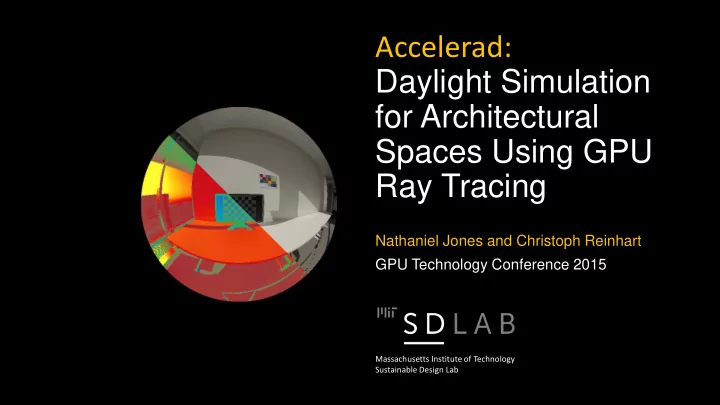

Accelerad: Daylight Simulation for Architectural Spaces Using GPU Ray Tracing Nathaniel Jones and Christoph Reinhart GPU Technology Conference 2015 Massachusetts Institute of Technology Sustainable Design Lab
What is Architectural Lighting Simulation? Experiential qualities of light • Orientation • Safety • Aesthetics Quantifying performance of buildings • How often a space is sufficiently lit to perform a task • Whether a space may cause visual discomfort
Why Simulate Daylight? Predict appearance with physical accuracy Reduce demand for electric lighting Balance lighting and views with cooling loads Light levels affect worker productivity Daylight spectrum affects alertness and health Simulation contributes to USGBC LEED certification Increasingly an input for other simulations
When to Simulate Daylight? CAD User Activity 10000 1000 Events 100 10 1 Time Command GH Add Delete Draw Save
How Long Does It Take? 10 3 primary rays Point sensor 10 5 Sensor grid 10 6 Glare prediction 10 8 Annual glare prediction 10 10 Adaptive glare prediction 10 12 Glare mapping
Global Illumination Irradiance Caching Validation Testing
Radiance Industry standard for architectural lighting and daylighting simulation Whitted-style recursive ray tracing Well validated and open source Simulation engine used by: • Adeline • Ecotect • DAYSIM • IES<VE> • Desktop Radiance • OpenStudio • DesignBuilder • SHADERADE • DIVA • umi Lawrence Berkeley National Laboratory. Daylighting The New York Times Building . http://windows.lbl.gov/comm_perf/nyt_visualizing.html
Radiance Tradeoff 138,844,405 rays 49 minutes 41,010,721 rays 1.5 minutes
Ambient Bounces Diffuse Bounces 0 1 2 3 4 5 cd/m 2 Mean Luminance 1.18 66.3 147 194 204 214 100% 0%
Whitted-Style Ray Tracing: CPU
Whitted-Style Ray Tracing: GPU
OptiX ™ Radiance (C/C++) if (rayorigin(&p, REFLECTED, r, refl) == 0) { • Built-in ray traversal using BVH VSUM(p.rdir, r->rdir, pnorm, 2.*pdot); checknorm(p.rdir); or KD trees rayvalue(&p); multcolor(p.rcol, p.rcoef); • User-defined shader programs addcolor(r->rcol, p.rcol); } • Ray generation • Intersection testing Accelerad (CUDA/OptiX) Implement to • Closest hit match Radiance if (prd.weight >= minweight && • Any hit prd.depth <= abs(maxdepth)) • Miss { float3 rdir = reflect(ray.dir, pnorm); Ray ray = make_Ray(hit_point, rdir, ray_type, RAY_START, RAY_END); rtTrace(top_object, ray, prd); result += prd.result * rcoef; }
Accelerad • Fork of Radaince source code • Uses OptiX ™ for all ray tracing • Free in beta
Results: Single Image Accelerad Radiance 12 seconds 92 seconds
Results: Single Image 100 80 Time (seconds) 60 40 4x 7x 20 0 Standard on Core i7-4770 OptiX™ on Quadro K4000 OptiX™ on Tesla K40 GPU CPU
Results: 120 Images 14000 12000 Time (seconds) 10000 8000 6000 5x 17x 4000 2000 0 Standard on Core i7-4770 OptiX™ on Quadro K4000 OptiX™ on Tesla K40 GPU CPU
Speedup 10000 1000 10x Improvement Time (seconds) 20x Improvement 100 10 Standard on Core i7-4770 OptiX™ on Quadro K4000 1 OptiX™ on Tesla K40 0.1 256 4096 65536 1048576 Primary Rays Jones and Reinhart, 2014. Physically based global illumination calculation using graphics hardware. Proceedings of eSim 2014: The Canadian Conference on Building Simulation , 474-487.
Global Illumination Irradiance Caching Validation Testing
Irradiance Caching: CPU
Irradiance Caching: GPU ?
First Pass: Geometry Sampling
Second Pass: Ambient Sampling
Parallel Irradiance Cache Direct Final Gather 1 st Bounce K-Means Irradiance Clustering Cache
Ambient Sampling: Second Bounce
Parallel Multiple-Bounce Irradiance Cache Direct Final Gather 1 st Bounce K-Means Irradiance Clustering Cache 2 nd Bounce Irradiance Cache 2 3 rd Bounce Irradiance Cache 3 n th Bounce Irradiance Cache n
Shortcoming
Parallel Multiple-Bounce Irradiance Cache Direct Final Gather 1 st Bounce K-Means Irradiance Clustering Cache 2 nd Bounce K-Means Irradiance Clustering Cache 2 3 rd Bounce K-Means Irradiance Clustering Cache 3 n th Bounce K-Means Irradiance Clustering Cache n
Results: 5 Ambient Bounces Accelerad Radiance 10 minutes 198 minutes
Results: 5 Ambient Bounces Accelerad Radiance 10 3 10 4 10 10 2 cd/m 2
Results: 5 Ambient Bounces Accelerad Radiance 10 3 10 4 10 10 2 cd/m 2
Speedup and Error 100 100% 25 100% Dual Tesla K40 Tesla K40 80 80% 20 80% Quadro K4000 Speedup Factor Speedup Factor Error 60 60% 15 60% Error Error 40 40% 10 40% 20 20% 5 20% 0 0% 0 0% 512 1024 2048 4096 8192 0 1 2 3 4 5 6 7 8 Clusters Ambient Bounces Jones and Reinhart, 2014. Irradiance caching for global illumination calculation on graphics hardware. 2014 ASHRAE/IBPSA-USA Building Simulation Conference , 111-120.
Global Illumination Irradiance Caching Validation Testing
Validation Study
Clear Sky, 9:30 AM 10 3 10 4 10 10 2 cd/m 2 HDR Photograph Radiance Accelerad 303 Minutes 11 Minutes
Clear Sky, 12:30 PM 10 3 10 4 10 10 2 cd/m 2 HDR Photograph Radiance Accelerad 321 Minutes 11 Minutes
Overcast Sky 10 3 10 4 10 10 2 cd/m 2 HDR Photograph Radiance Accelerad 294 Minutes 12 Minutes
Visual Comfort Metrics Daylight Glare Probability (DGP) Monitor Contrast Ratio (CR)
Accuracy 80 Clear Sky Overcast Sky 60 % Error 40 20 0 Time of Day DGP Error in Radiance: 24% DGP Error in Accelerad: 19% CR Error in Radiance: 24% CR Error in Accelerad: 25%
Speedup 28 x Media Lab 54 x Gund Hall 33 x Small Office 0 100 200 300 Time (minutes) Accelerad Radiance
Where Are We Going? Annual simulation using daylight coefficients Spatial mapping for adaptive glare analysis Detailed spectral analysis for alertness and health Optimized number and location of ambient records Performance optimization
Thanks
Information http://mit.edu/sustainabledesignlab/projects/Accelerad/ Questions? Nathaniel Jones <nljones@mit.edu>
Recommend
More recommend